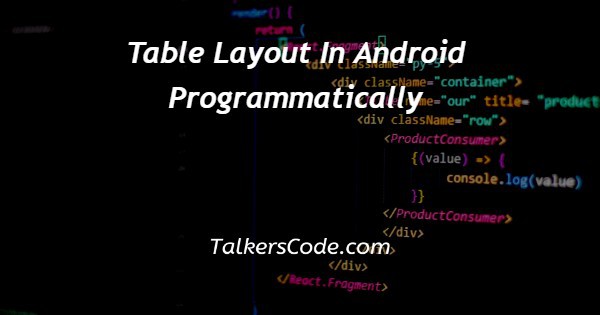Table Layout In Android Programmatically
Last Updated : Mar 11, 2024
IN - Android | Written & Updated By - Pragati

In this article we will show you the solution of table layout in android programmatically, ViewGroup class TableLayout is used to arrange rows and columns of child View components.
A borderless view will be displayed between rows, columns, or cells when the child items are arranged.
TableLayout functions almost identically to an HTML table and has the same number of columns in each row as the number of cells in that row.
We'll use the element to construct a row in a table. Views that are subordinate to a table layout are table row objects.
An ImageView, TextView, or any other view object can only be stored in each cell in a table row. Rows can consist of zero or more cells. An object's parent container determines a table's overall width.
Stretching and contracting are both possible with columns. If a column is shrinkable, its width can be reduced to fit the table into its parent object; if a column is stretchy, its width can be increased to fill any additional space that may be present.
When used in Table Layout, the stretch column attribute adjusts a column's default width. This width is set to be equal to the width of the broadest column.
However, it may also be used to stretch columns to fill in empty space.
A single column number or a list of several column numbers separated by commas should be inserted as the value for this characteristic (1, 2, 3...n).
Due to the fact that column numbers start at 0, if the value is 1, the second column will be widened to fill any empty space in the row.
A row's first and second columns will expand to fill the available space if the value is 1. However, it will not be stretched if it is 0.
A ViewGroup.LayoutParams.MATCH_PARENT layout parameter enforces each child's width to be ViewGroup.LayoutParams.MATCH_PARENT and the height of each child to be ViewGroup.WALLPAGE, but only if the height parameter is omitted.
Using TableLayout, you can arrange children into columns and rows. For TableLayout containers, rows, columns, and cells do not display border lines.
In a table, the number of columns will be equal to the number of cells in the row with the most cells. Empty space in a table is not prohibited. HTML supports cells spanning multiple columns. LayoutParams class.
Step By Step Guide On Table Layout In Android Programmatically :-
<TableLayout xmlns:android="http://schemas.android.com/apk/res/android" android:layout_width="match_parent" android:layout_height="match_parent" android:layout_marginTop="20dp" android:paddingLeft="10dp" android:paddingRight="10dp"> </TableLayout>
- Table rows can be defined using the table layout function.
- Then we create layout width and height using Android layout parent match.
- Then we give padding left and right to the program.
- Once the program has been closed, we return to the main screen.
Conclusion :-
Using TableLayout, you can arrange children into columns and rows. For TableLayout containers, rows, columns, and cells do not display border lines.
In a table, the number of columns will be equal to the number of cells in the row with the most cells. Empty space in a table is not prohibited.
HTML supports cells spanning multiple columns. LayoutParams class.
I hope this article on table layout in android programmatically helps you and the steps and mentioned above are easy to follow and implement.













